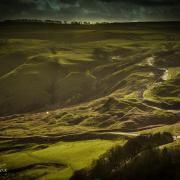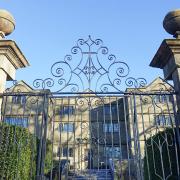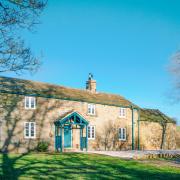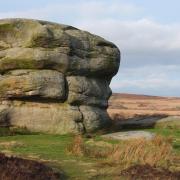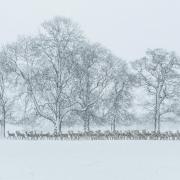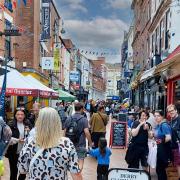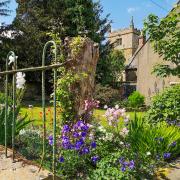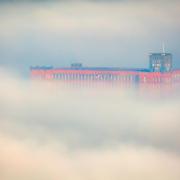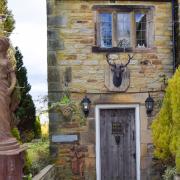Sharing its border with Derby; the Derbyshire Dales; and Erweash as well as East Staffordshire; Lichfield District; North Warwickshire; North West Leicestershire; and Tamworth, the district of South Derbyshire was formed in 1974.
The administrative centre of the South Derbyshire district is the town of Swadlincote, the county’s fifth-largest settlement behind Derby; Chesterfield; Long Eaton; and Ilkeston.
Settlements in South Derbyshire include Aston-on-Trent; Barrow-upon-Trent; Boulton Moor; Bretby; Calke; Castle Gresley; Cauldwell; Church Gresley; Church Broughton; Coton in the Elms; Chellaston Fields; Eggington; Elvaston; Etwall; Hartshorne; Hatton; Hilton; Hollington; Ingleby; Kings Newton; Linton; Lullington; Melbourne; Milton; Netherseal; Newton Solney; Newhall; Overseal; Repon; Rosliston; Shardlow; Smisby; Stanton by Bridge; Stenson Fields; Swadlincote; Swarkestone; Ticknall; Walton-on-Trent; Weston-on-Trent; and Willington Woodville.
This is a glorious part of the county, the rugged hills and dramatic landscapes found further north giving way to rolling hills, vast waterscapes and wonderful rural villages.
The district’s motto is ‘The Earth, Our Wealth’ and it’s easy to see why.
South Derbyshire contains approximately one third of the National Forest, the first forest to be created at scale in England for over 1,000 years.
A story of regeneration, large swathes of stunning nature now stands on land once exhausted and scarred by industry.
As well as its serenity, scenic beauty and undulating arable land, South Derbyshire is also characterised by water.

Here you will find Mercia Marina, with its 74 acres of walks, wildlife, food, drink, activities and accommodation all set in the largest inland marina in the whole of Europe.
The Trent and Mersey Canal; Willington Wetlands; Foremark Reservoir; and Staunton Harold Reservoir are all testament to this prominence of water in this area, which is crossed through by the River Trent – the third longest river in Britain.
South Derbyshire is brimming with heritage and history, of innovation and industry. Indeed, the area remains a hotbed for manufacturing, contributing to around 22% of jobs in the district against a national average of eight per cent.
South Derbyshire boasts around 3,500 businesses, from small enterprises that have passed through generations to multi-national giants such as JCB, Nestle and Toyota.
Home to more than 107,000 people (an increase of 13.3% from the 2011 census against a national average increase of 6.6%), South Derbyshire offers wonderful contrasts – from vibrant urban areas to tranquil rural villages.
Comprising around 130 square miles of land – making it the third largest district in the county behind Derbyshire Dales and High Peak - South Derbyshire is an area just waiting to be discovered, explored and enjoyed.
Well serviced throughout with stunning hospitality, versatile accommodation options, leisure pursuits for all and landscapes that will inspire, it plays a huge role in the county’s offering for both locals and visitors alike.
5 PLACES TO VISIT

Ticknall
Set in the National Forest, Ticknall is all you would want from a village. It’s quaint, characterful and exudes an ‘estate village’ charm – Calke Abbey, once the seat of the renowned Harpur-Crewe family being just a stone’s throw away.
A former Saxon settlement, these days Ticknall, which sits pretty much equidistant between Foremark Reservoir to the west and Staunton Harold Reservoir to the east, is popular for its myriad of scenic walking routes and boasts a number of quaint shops and pubs, with accommodation available.
The ‘Ticknall Arch’ on Main Street is Grade II listed, having been built over 200 years ago by the Ashby Canal Company.
READ MORE: Ticknall and it’s ‘Un-Stately’ Home
Shardlow
The village of Shardlow, close to border with Leicestershire, is synonymous with water and, at its zenith as a working canal village, was often referred to as ‘Rural Rotterdam’ and ‘Little Liverpool’.
Once a significant inland port on the River Trent, these days Shardlow’s legacy lives on – considered by many as Britain’s most complete surviving example of a canal village and boasting no fewer than 50 Grade II listed buildings.
Shardlow Heritage Centre offers a fascinating look into the village’s canal history, whilst the delights of Elvaston Castle and Country Park can be found just three miles north west for those looking to extend the day.
READ MORE: Shardlow - South Derbyshire’s waterway village

Swarkestone
Located nine miles south of Derby city centre, the historically significant village of Swarkestone certainly packs a punch as far as heritage is concerned, despite its small size.
As well as a thriving and successful cricket club (a common theme amongst South Derbyshire villages) there are numerous points of interest to enjoy here.
Swarkestone Bridge has the distinction of being the longest inland bridge in England and a scheduled Ancient Monument.
It was here in 1745 that Bonnie Prince Charlie and his men made their furthest venture south on their ill-fated quest to claim the crown for the Stuarts.
The village is also home to the 17th century gate pillars, surviving from the long since demolished Swarkestone Hall.
READ MORE: Why you should visit Swarkestone in South Derbyshire
Repton
Home to one of the country’s most revered and historic academic institutions in Repton School, Repton is a beautiful and tranquil village which benefits from stunning architecture that would look very much at home in an Inspector Morse episode.
Once the capital of the Anglo-Saxon kingdom of Mercia, Repton’s stunning mix of Georgian houses and cottages make this part of South Derbyshire a wonderful place to have a stroll.
Tempting walking routes abound, where you can follow in the footsteps of some famous ‘Old Reptonians’ such as Roald Dahl.
Don’t miss the ancient Medieval Cross or St Wystan’s Church either, both of which carry national importance and significance.
READ MORE: Exploring the village of Repton - one of South Derbyshire’s gems
Etwall
Equidistant between Derby and Burton-on-Trent, Etwall is another small South Derbyshire village with a big history.
Perhaps most famous for it almhouses (located adjacent to St Helen’s Church) and proud well dressing tradition, Etwall is also notable for being the location of the John Port Spencer Academy – Derbyshire’s largest secondary school.
A charming village with great amenities, its former station on the old Northern Line is no more, however visitors can still benefit – it now forms part of the National Cycle Network.
The village has 16 listed buildings, of which St Helen’s Church is Grade I listed, the south doorway dating way back to the 13th century.
READ MORE: Is Etwall in South Derbyshire a nice place to live?
4 OF THE BEST

Elvaston Castle
Located seven-and-a-half miles south east of Derby city centre, Elvaston Castle has the distinction of being the very first country park to have been opened in Britain.
Now run by Derbyshire County Council, this Grade II listed Gothic revival castle and accompanying vast grounds is the perfect location if you’re looking to tick off a lot of boxes from your day out.
Three hundred-plus acres of parkland? Check. Ornamental lake? Check. Extensive gardens? Check. Interesting features? Check. Wildlife? Check!
There are also plenty of lovely walking and cycling routes around the estate to enjoy.
Whilst there, why not head into the village and take in the additional 27 listed buildings as well as numerous places to eat, drink and stay.
READ MORE: Derbyshire Walk - Elvaston
Melbourne Hall
There can’t be many country houses which have the honour of having a whole city named after them.
However, Melbourne in Australia – the capital and most highly populated city in the state of Victoria – takes its name from South Derbyshire’s Melbourne Hall, which was once the seat of former British Prime Minister William Lamb, 2nd Viscount Melbourne.
A Grade II Georgian country house, Melbourne Hall is majestic to look at and the grandeur of its design is matched with the stunning gardens and open countryside which surrounds it.
So revered are the gardens that it is widely considered the best surviving 18th century garden in the manner of le Notre in the country, with a magnificent array of fauna, flora and wildlife.
melbournehall.com.
READ MORE: Spend a day in the Derbyshire market town of Melbourne

Calke Abbey
Any building that takes on a powerful moniker is sure to have something about it – Chatsworth House being the ‘Palace of the Peak’ a case in point.
Calke Abbey, built on the site of a former Augustinian Priory, is often referred to as the ‘Un-stately home’ and this in itself points to a unique, intriguing place – and that it most certainly is.
This imposing Baroque-style mansion showcases an estate in decline. It lacks the polished grace of many of Derbyshire’s esteemed country homes, but that’s the intention.
Take a nostalgic and revealing look into a country home which appears frozen in time from the 9th century and explore the vast 600 acres of historic parkland and nature reserves.
This is a country estate with a difference.
nationaltrust.org.uk/visit/peak-district-derbyshire/calke-abbey.
READ MORE: Why I love walking near Calke Abbey
Swadlincote Woodlands
This area, five miles south east of Burton on Trent, was one of the first to benefit from the creation of the National Forest in the late 1980s.
Today, it is home to over 40,000 trees along with wildflower meadows, abundant wildlife and ponds with plenty of important conservation work continuing.
Swadlincote Woodlands truly is an ideal place to get away from it all, with something there for all people of all ages.
There are plenty of trails to enjoy across the 80-acre park, whilst parking is also free (be aware, the car park is locked each day).
Picnic tables, a children’s play area and toilets also make this wonderful area of South Derbyshire the perfect family day out.
READ MORE: Why I love living in Swadlincote
THE LOCAL VIEW
I have lived around Rosliston all my life, as did my parents before me.
The village has a strong farming community, with many families having farmed the land here for generations, so I guess it’s no surprise I have stuck to my roots.
I feel overwhelmingly ‘Derbyshire’ and am more than content to spend my time in the area, exploring neighbouring villages, the National Forest and the various attractions – which seem to have grown as the years have gone on.
Rosliston Forestry Centre is a great place to take the grandkids. There’s so much to see and do and it always keeps them entertained and we’re frequent visitors there when they come to stay.
I said I feel overwhelmingly Derbyshire but I think one reason this area has always felt such a good place to live is how close we are to other counties.
My wife and I don’t venture out as far or as often as we used to but we’ve spent many a day in neighbouring Staffordshire and Leicestershire and would frequently make visits to Birmingham, which is less than 45 minutes away by road on a good run.
My son no longer lives in the area but I know he still holds Rosliston and the county close to his heart.
John - long-time Derbyshire Life subscriber
PROPERTY
According to data from the House of Commons Library (available at commonslibrary.parliament.uk) the latest available figures suggest that the average house price in South Derbyshire stands at £230,000.
The data states that Willington South and Repton have the highest average house price (£320,000), followed by Melbourne, Ticknall and Hartshorne (£317,500); Aston-on-Trent and Barrow-upon-Trent (£291,000); Hatton and Burnaston (£284,950); and Hilton and Etwall (£239,995).
The lowest average house price can be found in Swadlincote Central (£175,000).
HIDDEN GEM

Anchor Church
This is no ordinary church. In fact, it isn’t a church at all.
Found (although not particularly easily) close to the South Derbyshire village of Ingleby, Anchor Church is a series of caves which, it is believed, have been occupied since the 9th century.
Legends and stories around this ancient series of connecting caves abound and its quiet, solitary location set against water create a real aura on your approach.
Its name is believed to have originated from a hermit, St Hardulph, who is said to have lived and prayed here during the Anglo-Saxon period – with some historians claiming he was the exiled Anglo-Saxon King Eardwulf.
Today, there is no material evidence of the site having once been a home through the centuries, although holes carved out the rock which would have once provided doors and windows remain and give a sense of its history and past uses.
READ MORE: 10 places to visit in South Derbyshire








